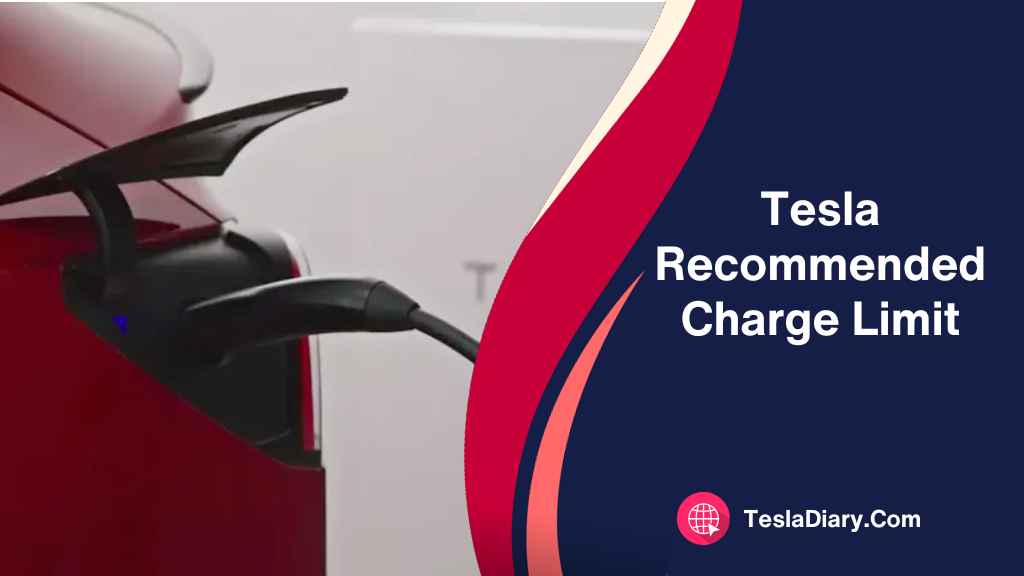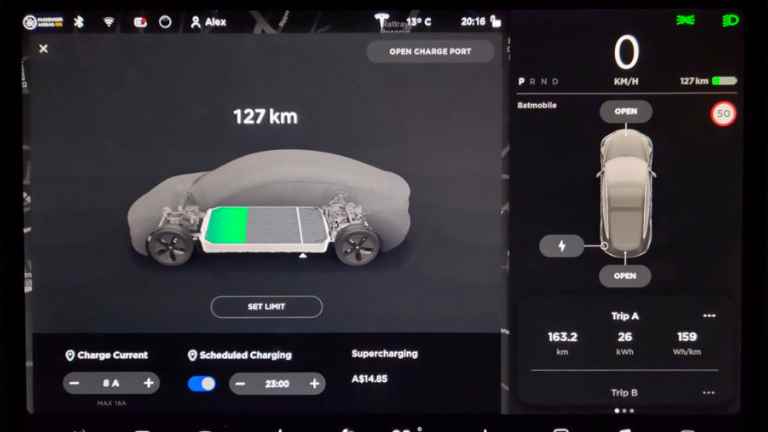In a world where electric vehicles are reshaping the future of transportation, Tesla stands at the forefront of innovation.
But in the quest for sustainable, high-performance driving, there’s a secret weapon that often goes overlooked: the charge limit.
Imagine having the ability to fine-tune your Tesla’s range and battery health like a conductor orchestrating a symphony.
This article dives deep into the hidden gem of Tesla ownership, unveiling the art of charge limiting and how it can supercharge your EV experience.

So, fasten your seatbelt, because we’re about to embark on a journey that unlocks the true potential of your Tesla like never before.
What’s the Utility of Tesla Charge Limit?
Tesla owners have the flexibility to control the charging capacity of their vehicles. By setting a charging limit, you can choose how much energy your Tesla receives during each charging session. This feature serves multiple purposes:
1. Enhancing Battery Longevity
The very heart of your Tesla is its battery pack, a marvel of engineering composed of thousands of lithium-ion cells. However, like any powerhouse, these cells aren’t immune to the effects of time and use.
Charging your Tesla to its full capacity on a regular basis can accelerate the wear and tear on these cells, leading to premature degradation. By setting a lower charge limit, such as 80% or 90%, you can slow down this aging process considerably.
Research has shown that keeping your battery within this range can potentially extend its lifespan by hundreds of charge cycles.
| Cell Voltage | Discharge Cycle* | Charge Limit |
|---|---|---|
| 4.25 | 500 – 800 | 100% |
| 4.15 | 700 – 1000 | 90% |
| 4.05 | 900 – 1500 | 80% |
| 3.95 | 1200 – 1800 | 70% |
| 3.90 | 1600 – 2500 | 60% |
You can see from the table that as the charge limit decreases, the discharge cycle (battery durability) increases exponentially. The sweet spot is around 80-90% charge limit. By maintaining this limit, you can achieve close to the full range of the vehicle while maintaining battery health.
2. Preventing Overcharging
Overcharging, a term that strikes fear into the hearts of electric vehicle enthusiasts, occurs when your battery is pushed beyond its safe voltage limit.
This can cause irreparable damage to the battery, resulting in a reduced range, decreased performance, and, ultimately, costly repairs.
Fortunately, by setting a charge limit, you act as a vigilant guardian, ensuring that your Tesla never ventures into the dangerous territory of overcharging.
3. Optimizing Daily Driving
For many Tesla owners, the daily commute is where the rubber meets the road. Most commuters don’t require the full range of their Tesla on a day-to-day basis.
By adjusting the charge limit to align with your typical driving needs, you can strike an ideal balance between range and battery preservation.
This is especially relevant for those who want to get the most out of their Tesla without compromising long-term performance.
For instance, if your daily routine typically involves commuting from home to work and back during weekdays, a prudent choice would be to set your charge limit at approximately 75-80%. This strategy aligns with your regular driving needs and maximizes your battery’s long-term health.
With a 75% charge, you can still enjoy nearly 65% of your vehicle’s advertised range, which is more than sufficient for your daily commute. However, for those occasional long journeys or weekend adventures that demand the full range of your Tesla, you can easily locate a Supercharger station to top up your charge to 90% or even 100%, ensuring you have the required mileage for your special trips without compromising your battery’s well-being.
4. Reducing Heat Generation
Charging a battery to its maximum capacity generates more heat within the cells. This excess heat can be detrimental to the health of the battery, causing internal damage over time.
When you limit your charging capacity, you mitigate heat generation, contributing to a cooler, more comfortable ride for your Tesla’s battery pack.
5. Energy Management
Charge limiting also plays a pivotal role in energy management, particularly in regions where electricity costs fluctuate throughout the day.
By scheduling your charging sessions during off-peak hours and setting a charge limit, you can save money on electricity bills while ensuring your Tesla is ready to hit the road when you need it.
6. Environmentally Conscious Charging
For those with a green conscience, charge limiting can be a way to align your Tesla usage with your environmental values.
By not overcharging and optimizing your battery’s health, you reduce the frequency of battery replacements, which in turn reduces the environmental impact associated with battery production and disposal.
In essence, the utility of charge limit extends far beyond the confines of a single setting on your Tesla’s touchscreen. It’s a versatile tool that allows you to personalize your EV experience, protect your battery investment, and make a positive impact on both your wallet and the environment. But, as with any powerful tool, understanding how to wield it effectively is essential. So, let’s explore how to harness this power to its fullest extent.
Drawbacks of Tesla Charge Limiting
While charge limiting offers significant benefits in terms of battery health and longevity, it’s essential to be aware of its disadvantages, as it may not be suitable for all Tesla owners. Let’s explore these drawbacks in greater detail:
1. Reduced Driving Range:
When you set a lower charge limit, your Tesla’s driving range is correspondingly reduced. This can be a significant drawback if you have a long daily commute or frequently take extended trips.
Lower range can lead to range anxiety, and the fear of running out of charge before reaching your destination, especially on long journeys. This can be a psychological stressor for some drivers.
2. Frequent Charging:
With a lower charge limit, you’ll need to charge your Tesla more frequently to maintain a sufficient range. This can be inconvenient, especially if you have limited access to charging infrastructure or a busy schedule.
More frequent charging can also be time-consuming. While charging at home overnight is convenient, making additional stops at charging stations during the day can eat into your time.
3. Limited Spontaneity:
A lower charge limit can limit your ability to take impromptu trips or detours. If you suddenly decide to visit a friend, explore a new place, or run an unexpected errand, you may find yourself needing to charge your Tesla before proceeding.
4. Charging Infrastructure:
If you primarily rely on public charging stations, a lower charge limit may require you to plan your trips around charging station availability. This can be inconvenient if stations are crowded or located far from your route.
When traveling long distances, you may need to make more frequent stops at Tesla Supercharger stations to top up your charge, extending your journey time.
5. Winter Weather:
In colder climates, battery efficiency can decrease, reducing your actual range even further. A lower charge limit combined with winter weather conditions can make it challenging to maintain an adequate range during the colder months.
6. Incompatibility with Autopilot Features:
Some Autopilot features, such as the ability to precondition your battery for fast charging, may require a higher charge limit. Limiting your charge too frequently could restrict the effectiveness of these features.
It’s essential to weigh these disadvantages against the advantages of charge limiting and consider your specific driving habits and priorities. For some Tesla owners, the drawbacks may be negligible, while for others, the convenience of a higher charge limit may outweigh the potential risks to battery health. Finding the right balance is key to making the most of your Tesla ownership experience.
How to Achieve Full Range in Tesla?
If you want to achieve the full driving range of your Tesla, you can simply set the charging limit to 100%. Here’s how to do it:

- Open your Tesla’s charging menu on the touchscreen.
- Select “Charging”.
- Adjust the charging limit slider to 100%.
- Confirm the change.
Keep in mind that while charging to 100% will maximize your range, it may impact the long-term health of your battery.
Bottom Line
Managing your Tesla’s charging limit is a crucial aspect of ownership that requires careful consideration.
While charging to the maximum capacity offers the longest range, it may come at the cost of battery longevity. On the other hand, setting a lower charge limit can protect your battery’s health but may result in reduced driving range.
Striking the right balance between range and battery health is essential to ensure that your Tesla remains a reliable and efficient vehicle for years to come.
Evaluate your driving habits and priorities to determine the most suitable charging limit for your Tesla, and remember that you can always adjust it as needed to meet your changing needs.

